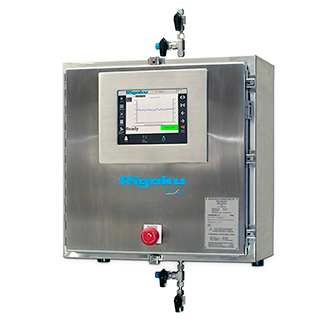
NEX OL Process Elemental Analyzer for Liquid Streams
Key Advantages & Features
Featuring advanced 3rd generation energy dispersive X-ray fluorescence (EDXRF) technology, NEX OL represents the next evolution of process elemental analysis for liquid stream applications. Designed to span from heavy industrial through to food grade process gauging solutions, the NEX OL is configurable for use in both classified and non-classified areas.
- Real-time process control by elemental analysis
- Measure elements aluminum to uranium
- From ppm levels to weight percent (wt%)
- Robust NEX QC+ optics with SDD detector
- Industrial touchscreen user interface
- Easy empirical calibration and routine operation
- Toolless routine maintenance
- Multiple remote analysis heads (non-classified)
- No dangerous radioisotopes

Video
Additional Notes
- Product Overview
- Application Notes
- No Radioisotopes
On-line, Real-time Analysis by EDXRF
Featuring advanced flow cell designs in combination with EDXRF technology, the Rigaku NEX OL process analyzer delivers on-line, multi-element analysis of aluminum to uranium for liquid streams. It serves a broad range of process control applications spanning from heavy industrial to food-grade process gauging solutions. The NEX OL is configurable for use in classified and non-classified areas, has easy calibration and routine operation, standard communications protocols, and features an intuitive industrial touchscreen user interface.
For superior analytical performance and reliability, the EDXRF measuring head assembly comes from the well-established NEX QC+ high-resolution benchtop instrument. This proven technology combined with a 50 kV X-ray tube, a silicon drift detector (SDD), and a standardized, optimized suite of tube filters make the NEX OL well-suited for many process control applications. In addition to analyzing liquid streams, the NEX OL serves web or coil applications, with the ability to perform multi-element composition analysis for the determination of coating thickness.
A Broad Range of Applications
NEX OL is engineered to solve a broad range of process control applications. Some of the most common applications include:
- Polyethylene / PET manufacturing: TPA and PTA catalysts
- Metal finishing: plating, pickling, and pre-treatment baths
- Mining: solvent extractions
- Chemicals: blending additives and resins
- Paper and plastics: release / barrier coatings, fire retardants, UV stabilizers
- Woven and nonwoven fabrics: fire retardants, UV stabilizers
- Metals: conversion coatings, other surface coatings
- Petroleum: lubricating oil additives and blending
- Pulp and paper: process water
- Industrial: wastewater
Rigaku Delivers Superior Performance Without Dangerous Radioisotopes
Globally, the petroleum industry continues to employ tens of thousands of radioisotopes in activities that range from exploration and production to distribution. The presence of these radioisotope sources, in such vast numbers, represents a statistically significant opportunity for theft and subsequent misuse. Governments worldwide now regard radiological terrorism, through the use of radiological dispersive devices (RDD) – often called “dirty bombs,” to be far more likely than use of a nuclear explosive device. In the context of the recent Deepwater Horizon Incident in the Gulf of Mexico, it is incumbent on the petroleum industry to evaluate liability exposure relative to its radioisotope inventory. Whether protecting the customer base or corporate shareholders, technology now exists to largely mitigate the risk associated with previous generation isotope-based technologies. Click through to read this article: Dirty Bombs and Liability Exposure in the Petroleum Industry.
